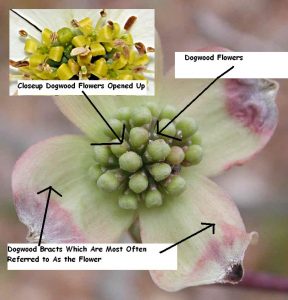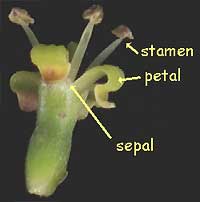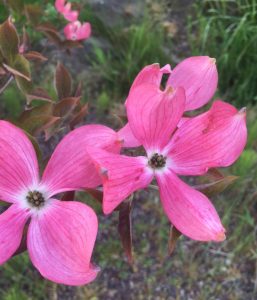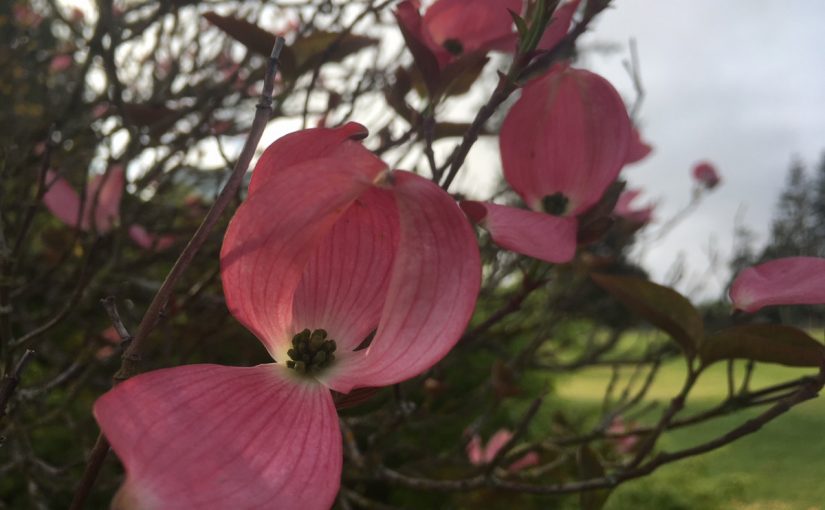Family: Cornaceae (also in this family: all dogwood varieties, bunchberry, tupelo). Members of this family are predominately woody trees and shrubs, with a few herbaceous perennials. This is a cosmopolitan family, found on every continent except Antarctica. Generally they will have opposite or alternate simple leaves, and will have four- or five-parted flowers clustered in inflorescences or pseudanthia, and drupaceous fruits (Zomlefer). The Cornus genus is the most well known of this family especially in northern temperate regions (of the 80 Cornaceae species, half belong to the dogwood or Cornus genus).
Genus: Cornus
Scientific Name: Cornus florida
Flowering dogwood is a really interesting cut flower as what we perceive to be the flower head is really not at all. Dogwood flowers are pretty inconspicuous, with the bracts often mistaken as the petals. Instead, dogwood has multiple flowers clustered together in the center of the four bracts.

Photo: Hametownshoppes Gardener

Photo: Backyard Nature
Flowering dogwood is native to eastern North America and northern Mexico. It rose in popularity as an ornamental tree in the 1730s due to its smaller size, colorful blooms, and curvy branches as well as because Thomas Jefferson began planting them at his home in Monticello, VA. Flowers can be red, pink, and white (Fast-Growing-Trees).
According to Backyard Nature and the University of Connecticut:
- Zone: 4-9
- Bloom Time: late spring to early summer
- Bloom Size: individual flowers are about 1/4in long, but the entire flower head and bracts are about 3-4in
- Height/Spread: 10-20ft/20ft (obviously would want to keep it a lot smaller to harvest as a cut flower)
- Soil: cool, moist, acidic, well-draining with lots of organic matter
- Site: Full sun promotes flowering but can tolerate partial shade, likes sloping sites
- Type: Woody
- Seed Type: Dicotyledon

For best vase life with flowers, harvest right away when the bracts open up. This is well before the actual flowers start opening up to avoid any pest or sun damage to the bract as well as to ensure they will not fall off the flower head. You can also force blooming earlier that natural by cutting when buds are swollen. Put these stems in water at 65-70F with a hydrating solution. This can be done as early as mid-March, but will take 2-4 weeks for buds to open (Armitage & Laushman).
While flowering dogwood harvested in late spring to early summer is obviously beautiful and lucrative with the flowering branches, it isn’t the only time you can harvest dogwood. Summer offers a good green foliage and autumn offers wonderful colored leaves a red fruits (Armitage & Laushman).
SOURCES:
Thistlehook Farm (Olympia, WA)
Cornus Florida, Flowering Dogwood–Plant Database, the University of Connecticut
Flowering Dogwood Flowers, Backyard Nature
Dogwood Trees: History, Facts, and Growing Tips, Fast-Growing-Trees
Guide to Flowering Plant Families, Wendy B. Zomlefer
Specialty Cut Flowers; The Production of Annuals, Perennials, Bulbs, and Woody Plants for Fresh and Dried Cut Flowers, Allan M. Armitage and Judy M. Laushman
